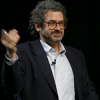Neil Gershenfeld

Neil Gershenfeld
Neil A. Gershenfeld is an American professor at MIT and the director of MIT's Center for Bits and Atoms, a sister lab to the MIT Media Lab. His research studies are predominantly focused in interdisciplinary studies involving physics and computer science, in such fields as quantum computing, nanotechnology, and personal fabrication. Gershenfeld attended Swarthmore College, where he graduated in 1981 with a B.A. degree in physics with high honors, and Cornell University, where he earned his Ph.D.in physics in 1990...
NationalityAmerican
ProfessionScientist
CountryUnited States of America
A Web browser for parrots isn't meant to serve a scalable business market,
You don't need personal fabrication in the home to buy what you can buy because you can buy it. You need it for what makes you unique, just like personalization.
We've had a digital revolution, but we don't need to keep having it. And I'd like to look after that, to look what comes after the digital revolution.
Fungible goods in economics can be extended and traded. So, half as much grain is half as much useful, but half a baby or half a computer is less useful than a whole baby or a whole computer, and we've been trying to make computers that work that way.
If anyone can make anything, anywhere. It fundamentally changes the meaning of business.
What we are interested in is merging the computer with the clothing so that all you need to do is get dressed.
The research is aiming to make a molecular assembler, one machine that can build, on a molecular scale, anything.
art became separated from artisans and mass manufacturing turned individuals from creators to consumers.
In a way, the Fab Labs are havens for inventive outliers in society.
In a sense, this is like open-source software, but for hardware.
In a few seconds, you can transform a two-dimensional sheet of acrylic into a three-dimensional object.
If you give people access to means to solve their own problems, it touches something very, very deep,
By personal fabrication, what I mean is ordinary people creating, rather than consuming technology, creating technology to solve local problems.
By not lobbing a few extra cannon shells, he could afford to make these community investments.